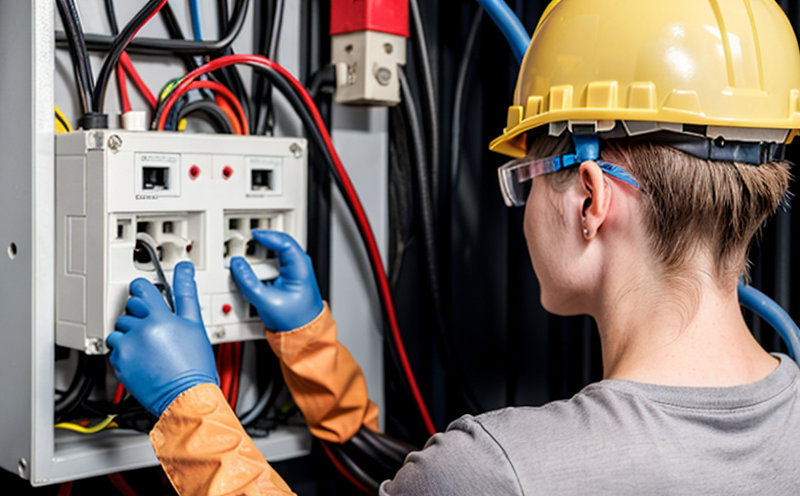EN 55032 EMC Requirements for Smart Home ICT Equipment
The European standard EN 55032 specifies limits and methods of measurement to ensure that electronic and electrical equipment, including smart home devices, do not emit excessive electromagnetic interference (EMI) that could disrupt other devices. This is crucial in the smart home sector where multiple interconnected devices operate within close proximity.
Compliance with EN 55032 ensures consumer safety, protects the integrity of data exchange between devices, and prevents interference in critical systems such as home security, energy management, and healthcare solutions. The standard applies to all ICT equipment used in smart homes that are intended for use by consumers or end-users.
Smart home devices often contain complex electronics that can emit electromagnetic fields (EMFs), which may interfere with other connected devices. For instance, a smart speaker might emit signals that could disrupt the operation of another device nearby. EN 55032 helps to mitigate such risks by setting strict limits on the emission levels and providing standardized testing procedures.
The standard covers both conducted emissions (EMI) and radiated emissions (ERI). Conducted emissions are those emitted through electrical wiring, while radiated emissions refer to signals that travel through space. Both types of emissions can have adverse effects if not controlled properly. The limits specified in EN 55032 apply to the frequency bands from 150 kHz to 8 GHz.
For quality managers and compliance officers, ensuring adherence to these standards is essential for maintaining brand reputation and meeting regulatory requirements. R&D engineers play a critical role in designing products that meet the specified limits, while procurement teams must ensure suppliers provide components compliant with EN 55032. Proper testing and certification are necessary steps to achieve compliance.
Testing typically involves setting up the device under test (DUT) in an anechoic chamber, a room designed to prevent radio waves from reflecting off its walls or ceiling. The DUT is then subjected to various measurement techniques to evaluate both conducted and radiated emissions. Compliance officers need to understand these procedures to oversee the testing process effectively.
Given the complexity of smart home devices, compliance with EN 55032 can be challenging. However, it is a necessary step towards ensuring product reliability and safety in an increasingly interconnected environment. The standards provide a framework for manufacturers to design robust products that integrate seamlessly into the smart home ecosystem without causing interference.
The scope of EN 55032 extends beyond just emissions testing; it also includes requirements related to immunity from external electromagnetic disturbances. This ensures that devices are not only resistant to interference but can also function reliably in environments where other electronic equipment may be operating nearby. Compliance with these standards is a significant step towards achieving broader interoperability and enhanced user experience.
Understanding the nuances of EN 55032 helps stakeholders in the smart home sector make informed decisions about product development, supply chain management, and regulatory compliance. By adhering to these standards, manufacturers can build trust with consumers who value reliability and safety above all else.
Scope and Methodology
| Test Parameters | Description |
|---|---|
| Conducted Emissions (150 kHz – 8 GHz) | Evaluation of emissions through electrical wiring using a network analyzer. |
| Radiated Emissions (30 MHz – 1 GHz) | Determination of emissions in free space using an isotropic antenna and spectrum analyzer. |
| Harmonics (5 kHz – 600 MHz) | Measurement of harmonic distortion caused by non-linear loads. |
| Radio Frequency Interference (RFI) Suppression | Evaluation of the device's resistance to RFI using a vector network analyzer. |
The methodology for testing EN 55032 compliance involves several key steps. First, the DUT is placed in an anechoic chamber equipped with appropriate measurement instruments such as spectrum analyzers and network analyzers. Conducted emissions are measured by connecting the DUT to a load impedance that simulates real-world conditions. Radiated emissions are then evaluated using an isotropic antenna positioned at specific distances from the device.
For harmonics testing, a vector network analyzer is used to measure the distortion caused by non-linear loads within the specified frequency range. RFI suppression tests assess how well the DUT can operate in environments with high levels of interference. These tests are critical for ensuring that devices meet both emissions and immunity requirements.
The acceptance criteria for EN 55032 compliance require that all measurements fall below predefined limits set by the standard. Compliance officers must ensure that all test results meet these stringent requirements to achieve successful certification.
Eurolab Advantages
At Eurolab, we offer comprehensive services tailored specifically for EN 55032 compliance testing of smart home ICT equipment. Our state-of-the-art facilities provide anechoic chambers equipped with the latest measurement instruments to ensure accurate and reliable test results.
- Accurate Testing Equipment: We use high-precision spectrum analyzers, network analyzers, and other specialized tools that meet international standards for EMC testing.
- Expertise in Smart Home Devices: Our team of experienced engineers has extensive knowledge of the unique challenges associated with smart home devices, allowing us to provide targeted advice and solutions.
- Comprehensive Reporting: We offer detailed reports that not only list compliance status but also provide insights into areas where improvements can be made.
- Regulatory Knowledge: Our team keeps abreast of the latest updates in regulatory requirements, ensuring our clients are always compliant with current standards.
By choosing Eurolab for your EN 55032 compliance testing needs, you can rest assured that your smart home ICT equipment will meet the highest quality and safety standards. Our commitment to excellence ensures that every device tested leaves our facility fully compliant and ready for market launch.





